The Nancy Jones House stands today between Cary and Morrisville. In its heyday, it was a singular house on what once was the original stage coach road between the capital, Raleigh, to the newly formed University of North Carolina at Chapel Hill, and the former state capital at Hillsborough. What makes this house that seems unexceptional today such a local and county treasure? Read on and find out!
 Until the mid-1700s there was little in the way of any development in the Cary area. The land had been forest land and a hunting ground for the Tuscarora Indians until early white settlers arrived.
Until the mid-1700s there was little in the way of any development in the Cary area. The land had been forest land and a hunting ground for the Tuscarora Indians until early white settlers arrived.
First, a little county formation history. Early in North Carolina’s history, Craven County extended far inland from the coast, up to and beyond today’s Wake County. In 1746, Johnston County was formed from Craven and included the Wake County area, and finally, in 1771, Wake was carved out of Johnston, along with parts of Chatham and Orange Counties. Keen researchers will keep in mind county formation and county line changes when searching for old records.

The earliest known landowner in the Cary area was Francis Jones of Edgecombe Co, NC. He received a land grant from Lord Carteret, later Earl Granville, in 1749 for 640 acres of land (a square mile) in Johnston County which later became Wake County and even later a part of the Cary area. He was a prosperous landowner in Edgecombe County and bought this land grant in Johnston County with some of his wealth. Buying land outside one’s area was not an uncommon practice in the day for those with the means to invest in real property.
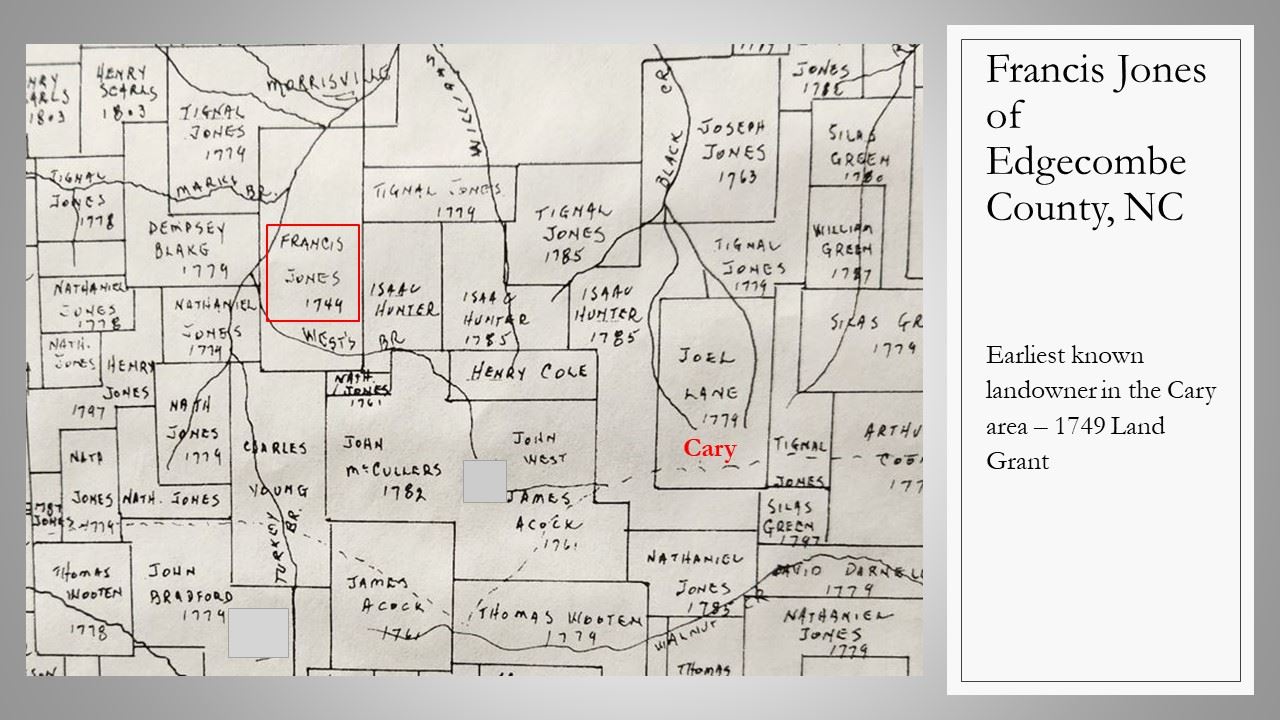
This is part of a map compiled by Mr Allen B. Markham, Jr. of Durham in the 1970s. He used the original land grants found at the North Carolina Archives to plot these early grants in Wake County, formerly Johnston County. Although this map is a “best guess” based on vague descriptions of land, it does show where each land grant lay in approximation to other grants. The map shows Francis Jones’ land, later surrounded by other notable Jones family land grants. Interestingly, there is no proof that Francis Jones lived on this local property. His will was probated in Edgecombe County in 1755, which leads us to believe he resided there. In his will, Francis willed the Johnston (later Wake) County land grant to two of his sons: Nathaniel (later known as Nathaniel Jones, Senior) and Tignall or Tingnall Jones, both of whom became influential figures in Wake County history. Francis also owned additional property in current Wake County which he left to other sons and a son-in-law and which spread the influence of the Francis Jones family across the county.
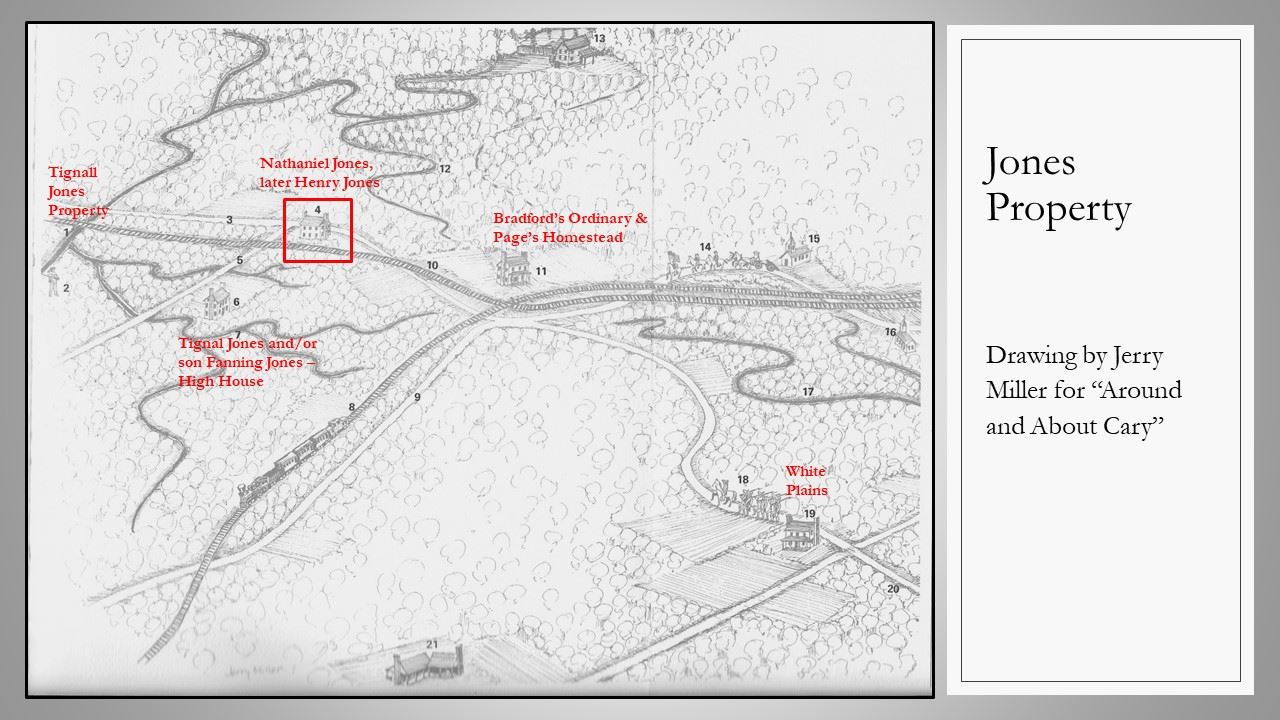
A map drawn by local artist Jerry Miller for the first edition of “Around and About Cary” contains this bird’s eye view of the area, showing the relative locations of notable features and houses, including the Nathaniel Senior/Henry/Nancy Jones House, Bradford’s Ordinary/A F Page House (destroyed by fire in 1970), Nathaniel Jones of White Plains House, the Tignall Jones Property, and the High House built by Tignall and/or son Fanning Jones. Note that all of these early Cary area historic houses are gone, except the Nancy Jones House, which makes its restoration even more important.
Now that we have talked about the land, let’s talk about all the Nathaniels – this is where it gets “fun”!
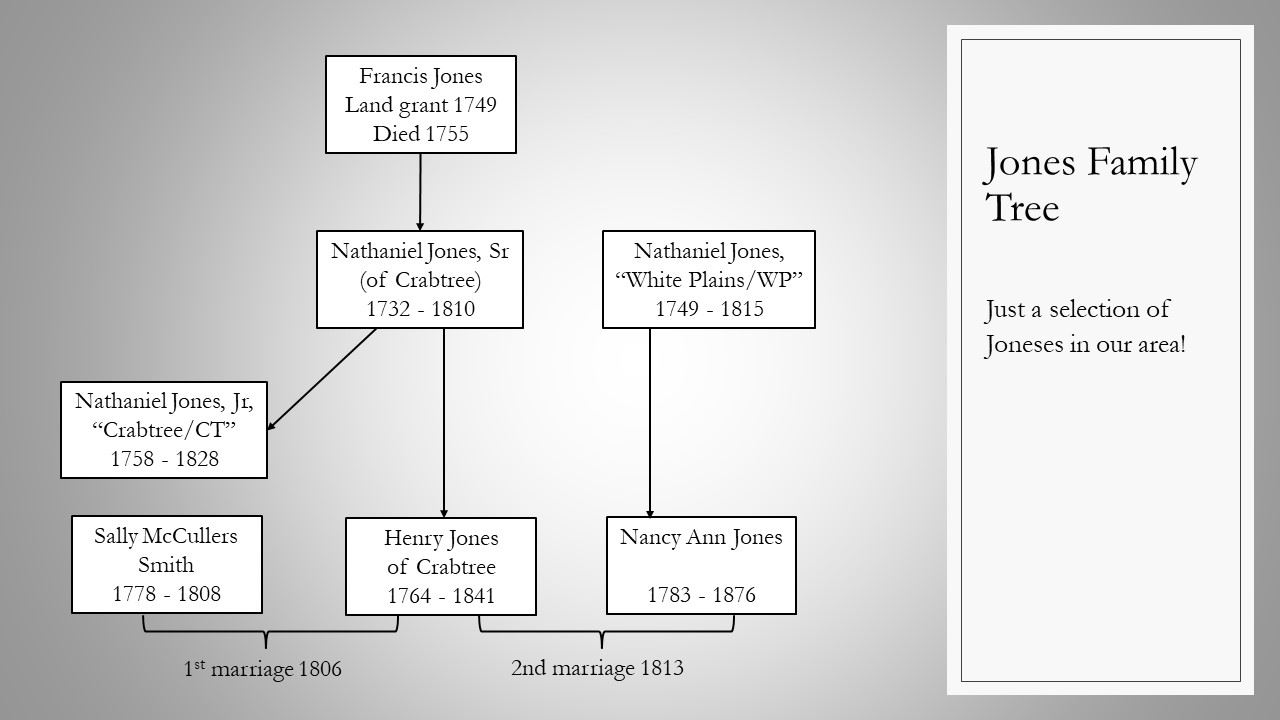
The Joneses are complicated families, some are related and some not. This is what makes research interesting and challenging.
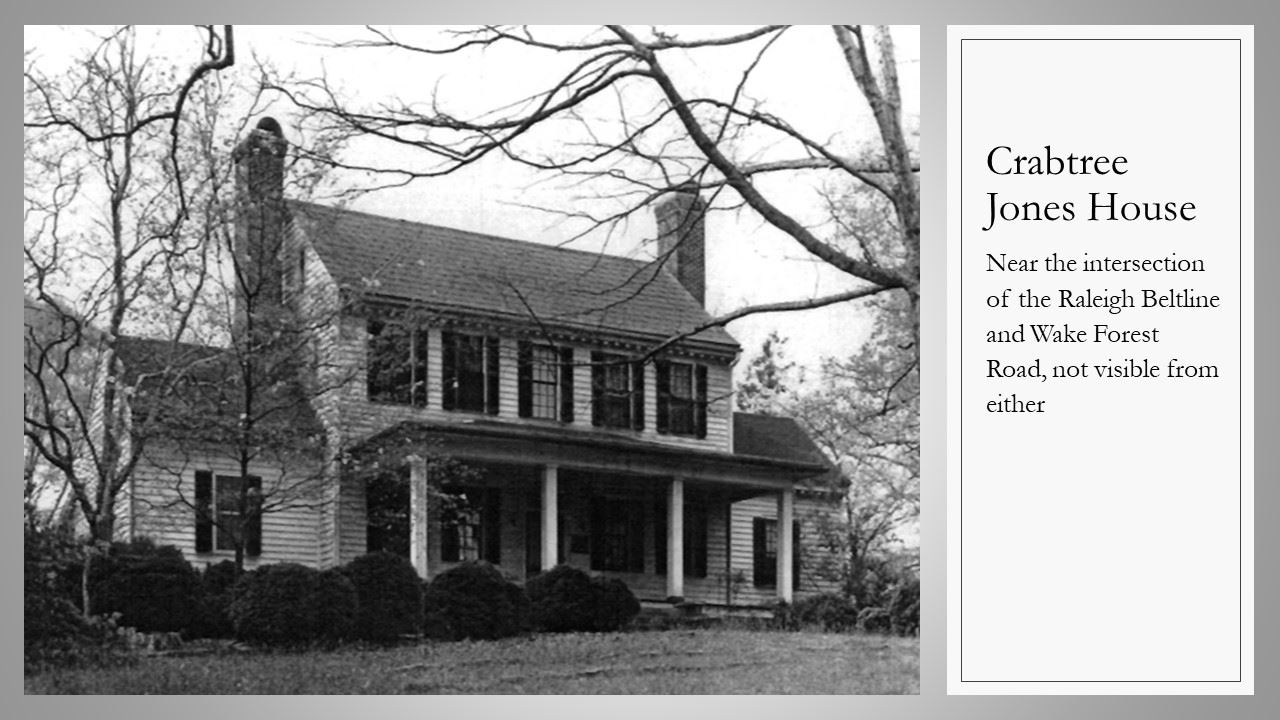
Nathaniel Jones, Senior had a number of children, two of which we will mention here: first, Nathaniel Jones, Jr, commonly referred to as Nathaniel Jones of Crabtree (C. T.) or Crabtree Jones. The other son is Henry Jones, sometimes referred to as Henry Jones of Crabtree. In his will, probated in 1810, Nathaniel, Senior divided his land holdings between all his sons. The land would legally pass to the sons after the death of his wife Anna Snickers (or Sniggers) Jones.
Nathaniel Jones, Jr, (one of the many Nathaniel Joneses in our area) received land on Crabtree Creek in Raleigh, an eastern section of the creek that runs across a large part of Wake County. This photo shows the impressive house that belonged to Nathaniel “Crabtree” Jones, and it stands today near the beltline and Wake Forest Road in Raleigh. It was moved from its original site and restored. In this way, it mirrors the related Nancy Jones house which has also been moved and is in the process of restoration. The Crabtree Jones House serves today as a private residence. Research indicates that it was built sometime after 1810 and before 1820. Although there has been a large amount of research done on the house, we will move on from the Crabtree Jones House.
Nathaniel, Senior gave his son Henry Jones “..my old tract of Land on Crab tree whereon he lives together with all other land taken up by me or bought by me joining said Old tract on the Waters of Crabtree creek, also the land whereon I now live to him and his heirs...” The wording of the will and the known location of the original grant places this land on the western end of Crabtree Creek in Wake County.
Establishing sons on their inheritance but not actually making the land available to them in their own names until the father and/or mother had died was not an uncommon ploy by wealthy landowners. This technique made it more likely that the sons would settle and stay in the area, rather than catching the “go west, young man” fever that many people of the time caught. This was certainly the case for the sons of Nathaniel Jones, Senior - three of the four remained in Wake County for the remainder of their lives.
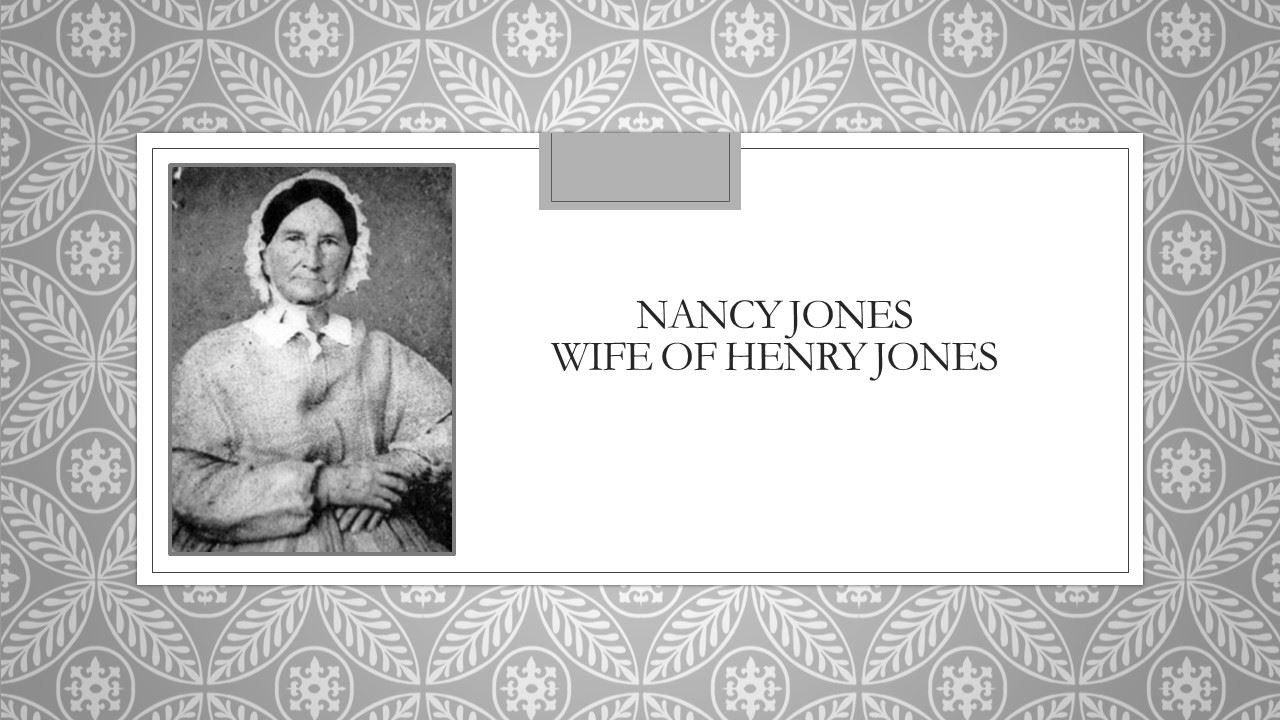
This brings us to the Nancy Jones House. Here is a portrait of Nancy Jones, probably in her middle years. Unfortunately, we do not have a portrait or photograph of her husband Henry. After extensive research on the house, including National Register documentation, deeds and wills, it still remains unclear exactly when or by whom the house was built. The house is variously dated by experts to 1803 - 1825, with most settling on circa 1803, but that still doesn’t clear up who built it, Henry or his father, Nathaniel Jones, Sr.
According to one researcher, Nathaniel Jones, Senior built and lived in the Nancy Jones House until his death in 1810 and in his will devised it, at his wife Anna Snickers Jones’ death (sometime after 1810), to their son Henry. Could Henry have lived with his parents, Nathaniel and Anna, until their deaths? Would he have married and brought spouses into the parental house? These are unanswered questions. Regardless of who actually built the house, and who resided in the house and when, what we do know is the Nancy Jones House was the home of Henry Jones.
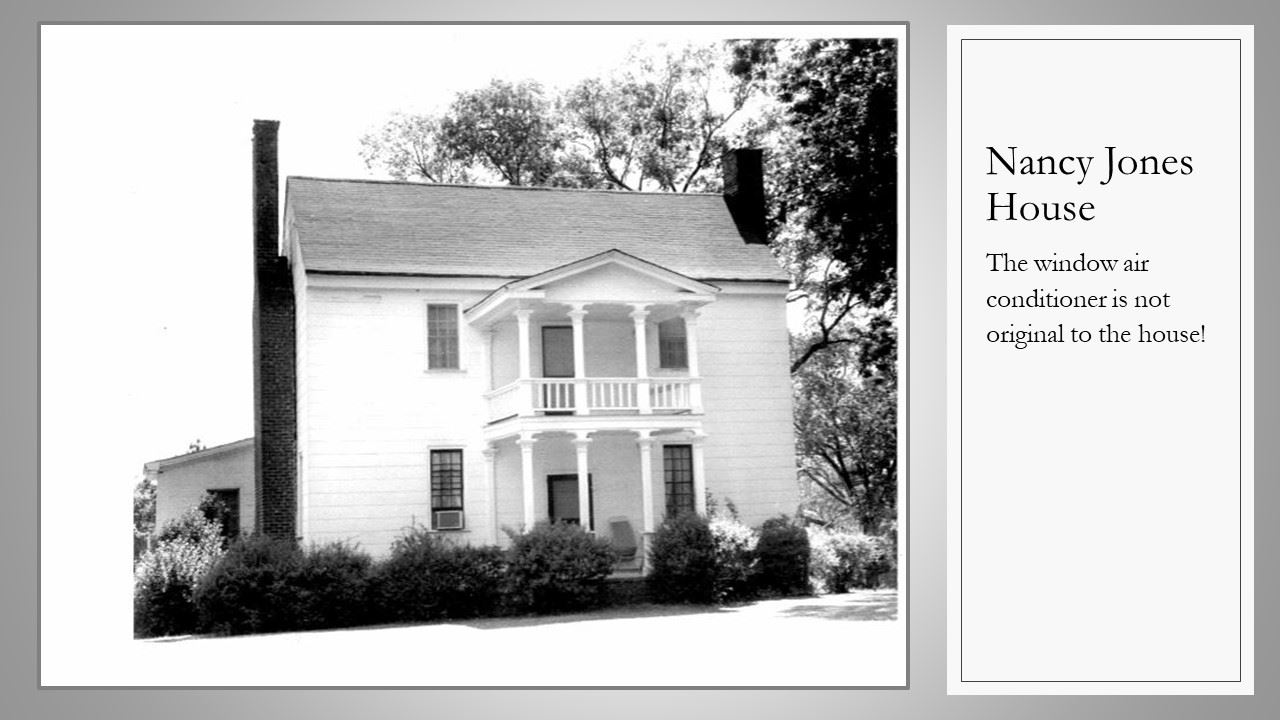
The house was built along the stage road from Raleigh to Hillsborough and would have been one of the most impressive houses along the way. It was one of the very few houses that was painted bright white, which would have made it stand out for more than just its imposing size relative to modest wood-built, one-story homes along the way. Located about 10 miles from Raleigh, it would have been a convenient stop for travelers to get out, get some liquid refreshment and a meal and stretch their legs. There is no indication that it was ever an inn, simply a stage coach stop.
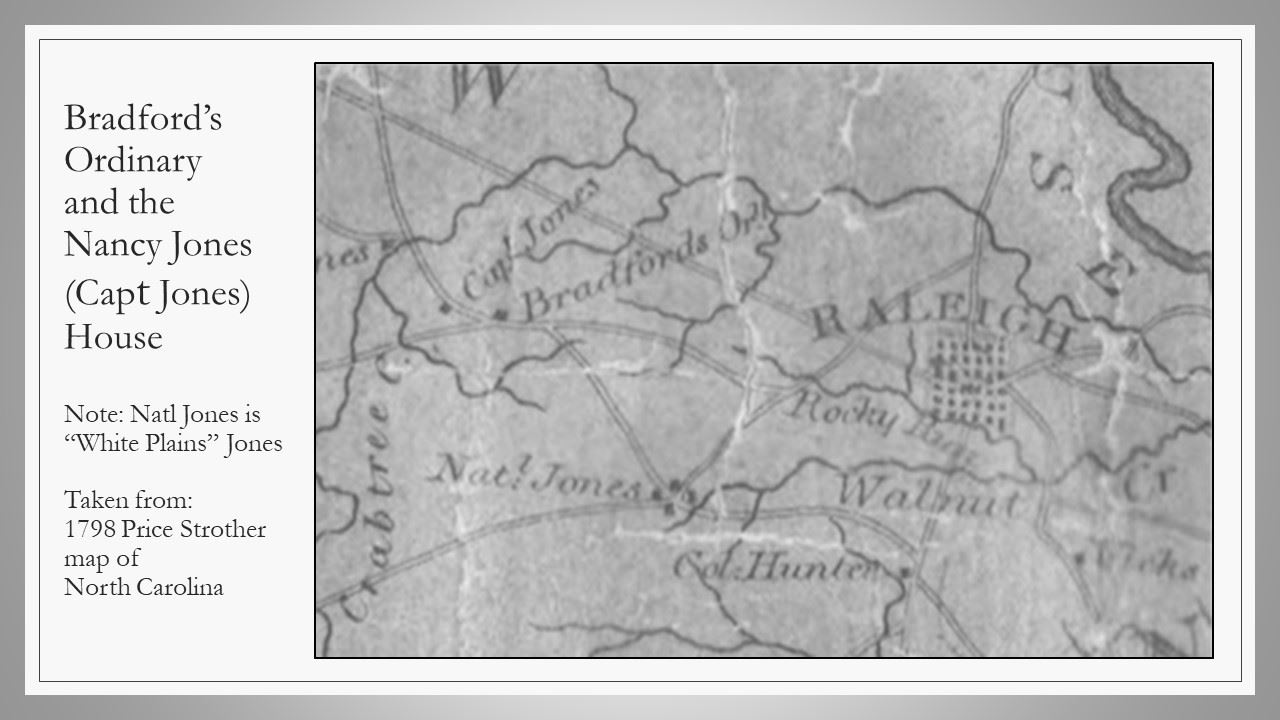
There is no firm evidence as to when the house started to function as a stop along the stage road. Bradford’s Ordinary was the older tavern/inn/ordinary located on the site of the Cary Town Hall campus (also shown in a previous photo), and was located along the stage road east of the Nancy Jones House toward Raleigh. John Bradford is mentioned in Wake County Court Minutes numerous times starting as early as 1772, shortly after Wake County was formed and court minutes recorded. The December 1794 Court session showed him as an overseer of the road “from the fork near the said Bradford’s Tavern to Babb’s Lick”. (A fork in the road at Bradford's Ordinary is shown on the map above, but Babb’s Lick is not!) Hands of Nathaniel Jones, Sr and John Bradford were to work on the said road. Any mention of Bradford’s Ordinary and John Bradford, the operator of the Ordinary, disappeared from county records around 1810, and that disappearance would have left a gap in stagecoach services along the route. This loss provided a great opportunity for the Joneses to fill the gap.
Wake County Court Minutes also recorded to whom and when tavern, public house, and ordinary licenses were granted. Although there is not a specific mention of the license granted to Bradford to operate the ordinary, the minutes DO record that Nathaniel Jones of White Plains received a public house license for his home in 1794. Operating a stage coach stop would not have been an unfamiliar undertaking for Nancy Jones, a daughter of Nathaniel Jones of White Plains, who witnessed the operation of a similar business in her own childhood home.
Let’s take a peek inside the house that we recognize from the outside.
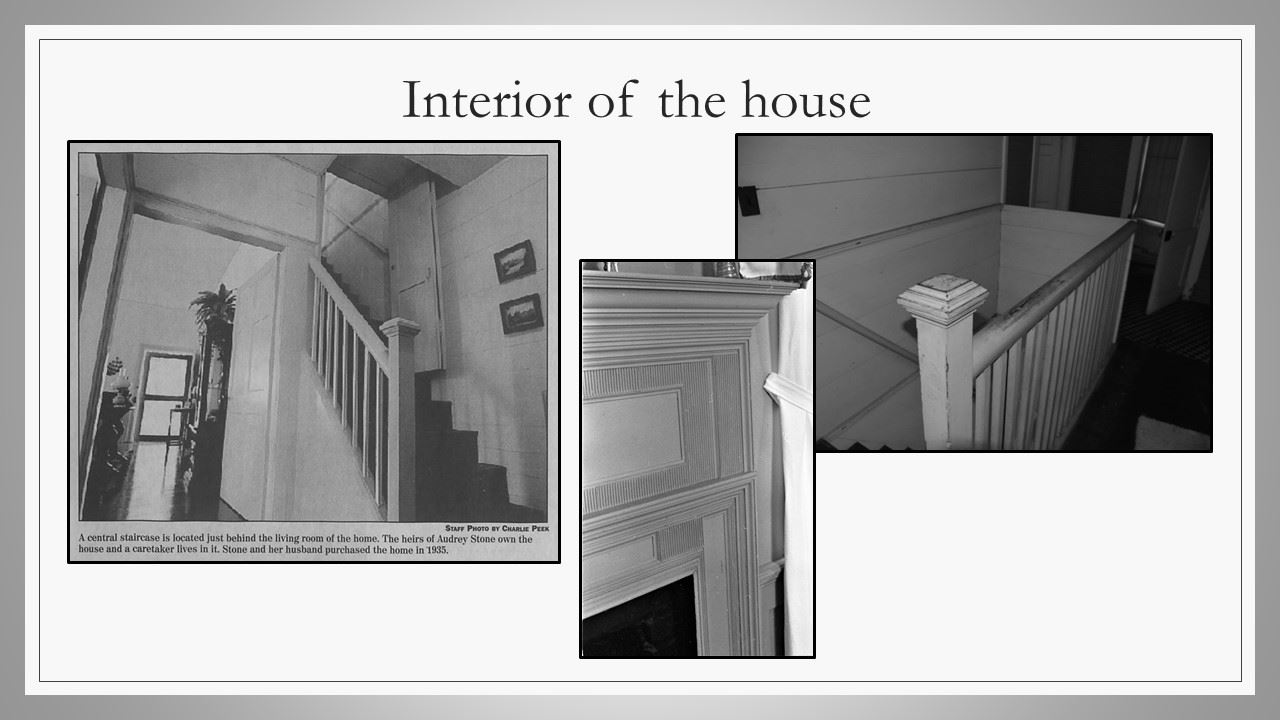
These photos of the house in more modern times show high quality woodwork, such as this mantel, throughout the house. We also see shiplap and robust newel posts in these photos.
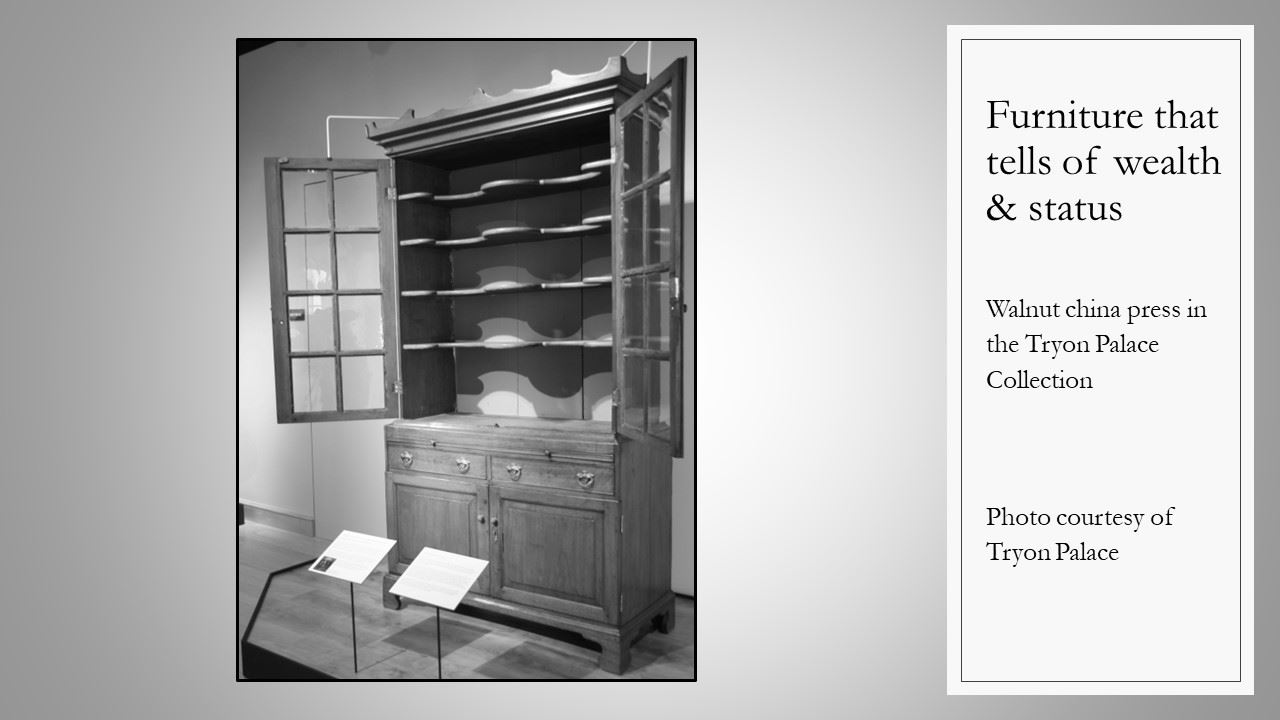
The search for information about the house and the Henry Jones family led to the discovery of a piece of furniture in the Tryon Palace collection that was auctioned by a Jones descendant around 2010. This impressive walnut china press with yellow pine secondary wood and original glass is a lovely example of eastern North Carolina furniture and points to the wealth and social status of the residents of the Nancy Jones house. It dates to the late 1700s, so it could have been owned by either Nathaniel Jones, Sr OR Henry Jones his son, or both, with the furniture being passed down in the family. Henry was born in 1766, and being around 30 years old at the time of the making of the piece, it is possible that he could have been the purchaser, although he was still a single man at the time. His father, Nathaniel, Senior, could also have made the purchase. What we do know is that it descended through and stayed in the Jones family until it sold in 1982 to Tryon Palace, who supplied the Friends of the Page Walker Hotel with research information and this photograph. Just think about all the people who traveled along the stage road and stopped at the house, including a US President, governors and other dignitaries, as well as “ordinary” folk and visiting family members. They probably saw this very piece of furniture filled with china. If only the walls, and the furniture, could talk!
So we know something about the house itself and the land that it stood on. Let’s talk people!
First, let’s look at the family tree of Henry Jones, son of Nathaniel Jones, Sr., brother of Nathaniel Jones of Crabtree, and son-in-law of Nathaniel Jones of White Plains! Believe it or not, these three aren’t all the Nathaniel Joneses in Wake County. We will meet another one later.
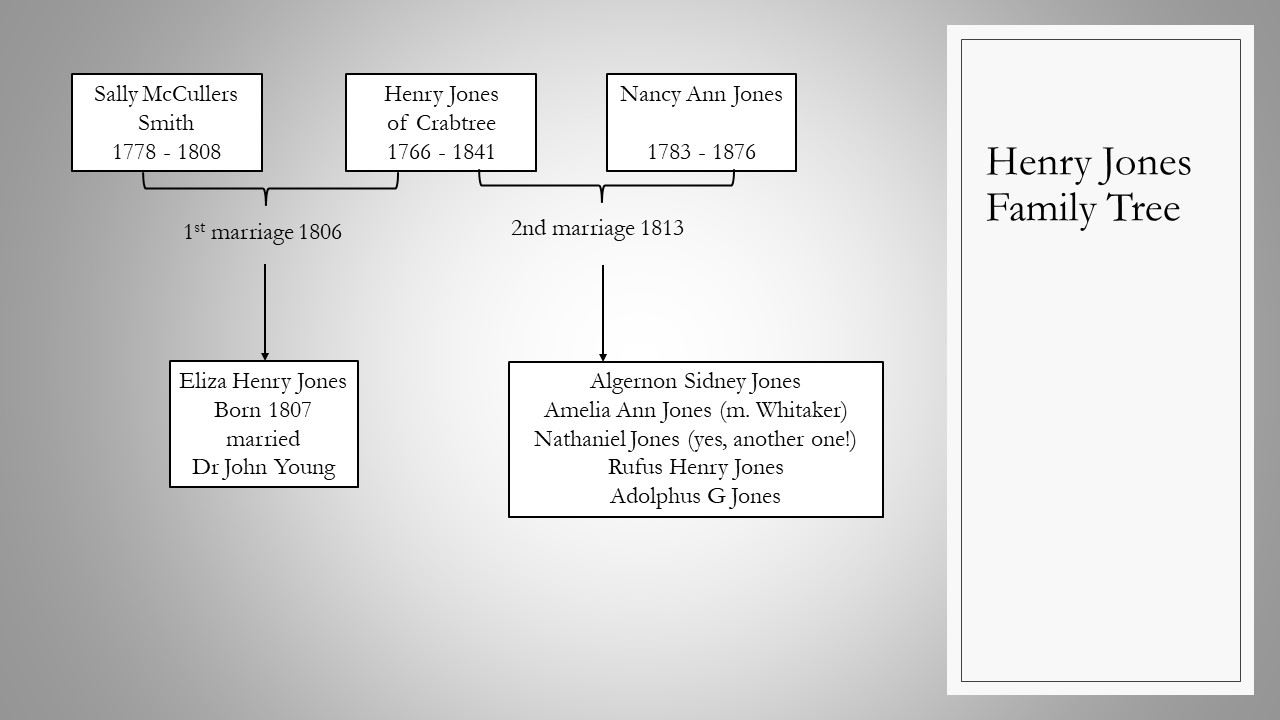
It is surprising to some that Nancy Jones was not Henry’s first wife. This family tree shows Henry’s two marriages and the children of each marriage.
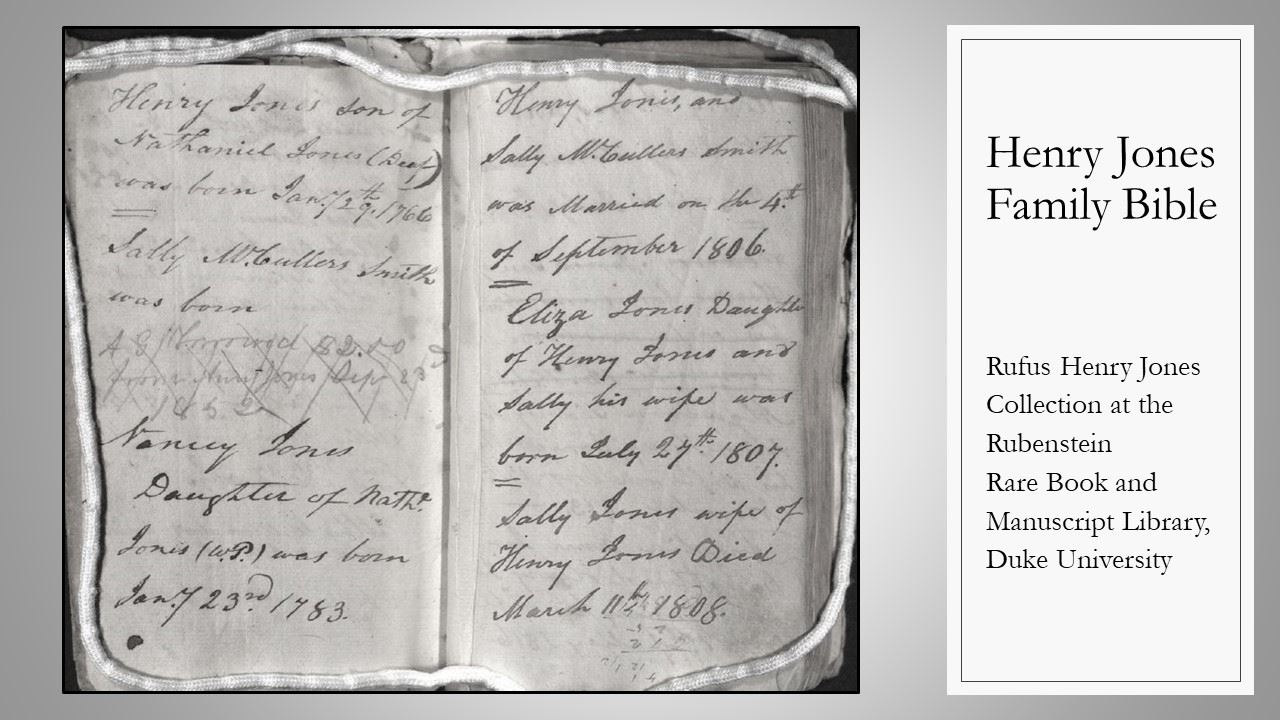
The David M Rubenstein Rare Book and Manuscript Library at Duke has a collection of letters and documents donated in 1958 by the family of Rufus Henry Jones, son of Henry and Nancy Jones. The collection contains a journal with family information that listed the earlier marriage. Here is the page outlining some of Henry Jones’ family information. You can see that he recorded his marriage to Sally McCullers Smith and the birth of their only child.
These pages of the family Bible go on to tell the sad story of this first marriage. Henry and Sally McCullers Smith married in 1806 in Johnston Co, NC when Henry was 40, and their one child, Eliza Jones was born in July 1807. On this page, it’s interesting that Henry is referred to as the son of Nathaniel Jones who is noted as being deaf.
Sadly, Sally died in March of 1808 leaving behind Henry and their child Eliza, who was not even a year old. Henry remained a widower for five years.
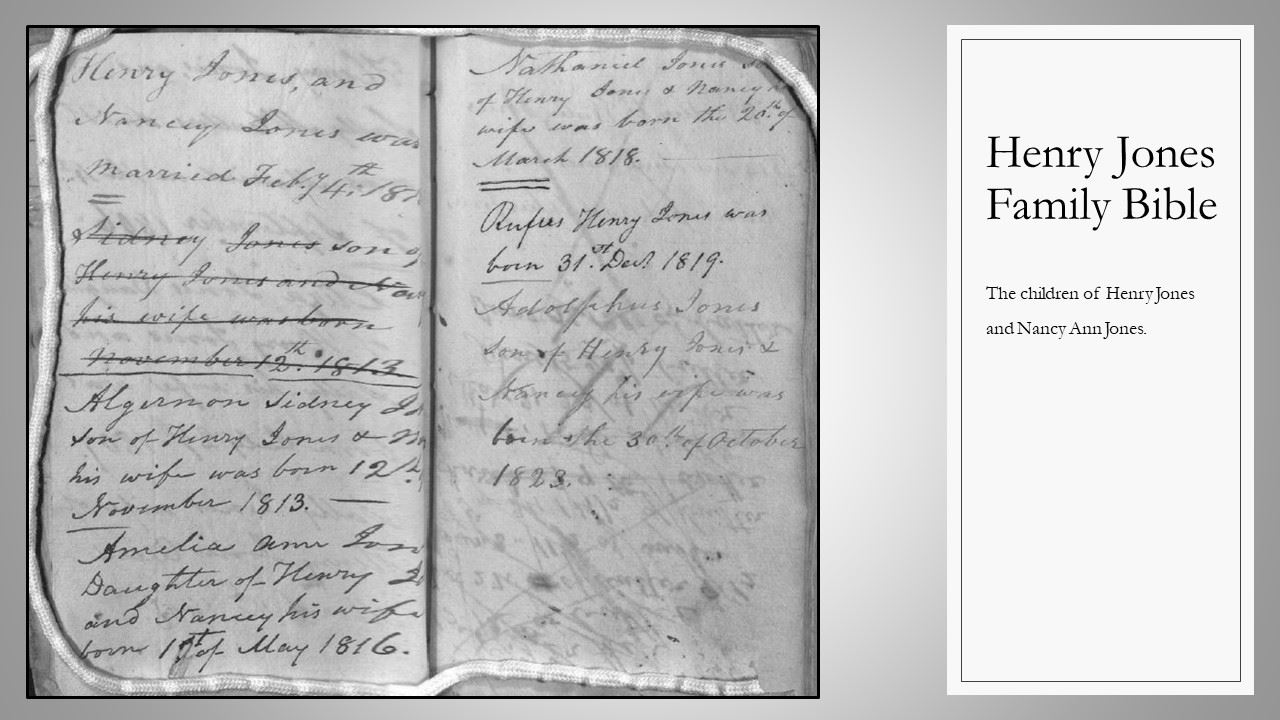
But here is where Nancy Jones, daughter of Nathaniel Jones of White Plains arrives on the scene. Nancy was born in 1783, so she would have been age 30 at the time of her marriage to Henry in 1813, so no spring chicken at that time. Let’s look at the family tree again.

Henry and Nancy had five children together: Algernon Sidney, Amelia Ann, Nathaniel, Rufus Henry, and Adolphus G. Although there are no letters that give details of the children in their “growing up years”, the letters we have from about 1836 on indicate that all the children from the second marriage had a deep affection for their half-sister Eliza. Eliza married Dr. John Young in 1824, and the Young family moved to Tennessee in the mid-1830s and later on to Arkansas where both passed away. Many of the letters and correspondence we have today that shed light on the Jones family stem from Eliza’s move out of the area.
There are actually two sets of letters that have been uncovered in recent years. One set came from descendants of Eliza Henry Jones Young in Louisiana, and the other set is, as mentioned, at the Rubenstein Library at Duke in the Rufus Henry Jones Collection. The Friends will feature the most interesting parts of them in future blog posts and presentations. But here are some sneak peeks!

First is a reference to peach wine or brandy, which will feature in a couple of anecdotes!
In 1836 on Christmas Day, Henry Jones wrote a letter to his daughter Eliza Young who by this time was already married and living in Tennessee.
“You wish to know my method of making Peach wine; In the first place I beat and press the peaches as late in the Evening as possible in Order to give the liquor as little chance to ferment as possible, which it will be sure to do in warm weather, next morning have a good clean tight Barrel ready, with about Eight gallons of Brandy in it before you begin to put in the peach Juice…” The letter goes on after more explanation to say, “I never added Sugar to any I ever made, but am Satisfied it would be the best, say one pound to 10 gallons I think would be enough…”
So, now that you know the recipe, who is going to start making peach brandy? Peach trees were not uncommon in this area, and later on in Cary’s history, Cary founder Frank Page grew peach trees and harvested and canned the fruit for sale.
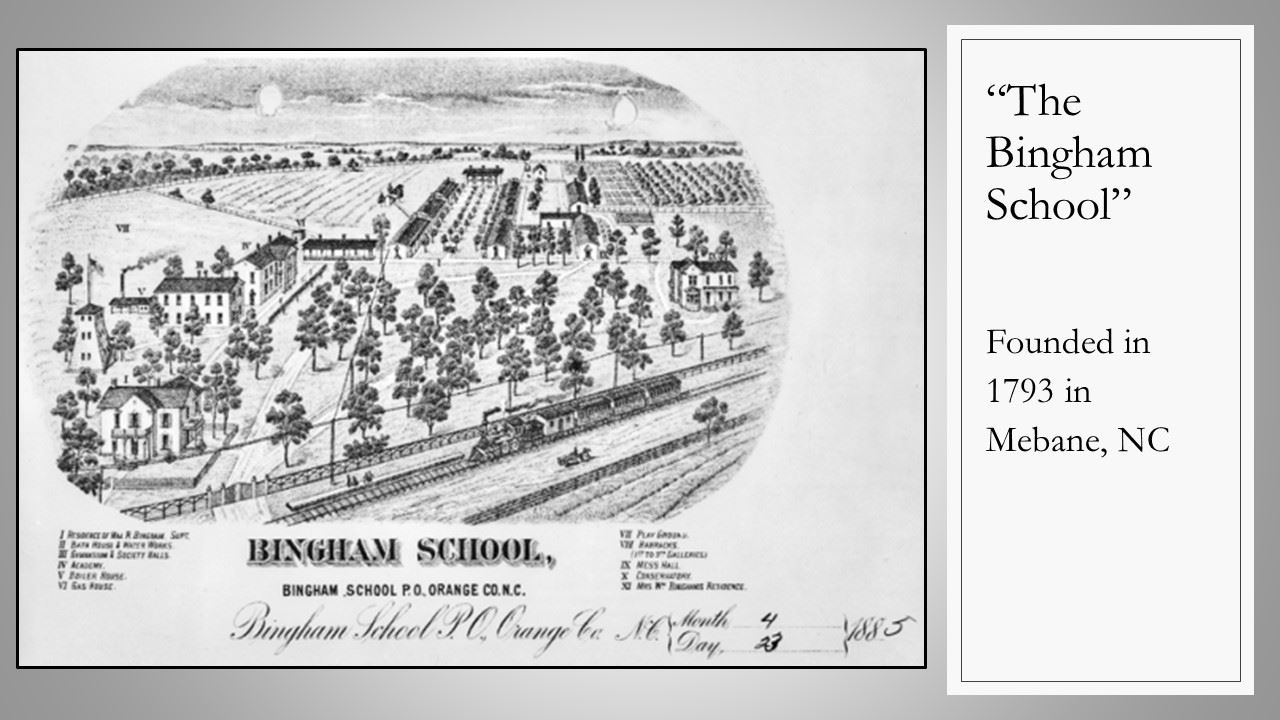
Henry Jones was prominent and wealthy enough to send his sons to an academy or prep school and then on to “the university”, as UNC was known. The stage coach went right by the house, so getting to school was not as arduous a journey as it might have otherwise been.
Amelia Ann Jones wrote to her half-sister Eliza Young on January 4, 1836 about her brothers’ recent time at the Bingham School in Mebane, NC:
"Nat and Rufus are here enjoying their vacation very much they brought home excellent reports. Mr Bingham considers Rufus the brightest scholar but bestows on Nat equal praise for other virtues." Cary’s most famous son, Walter Hines Page, son of Cary’s founder, A F “Frank” Page, also attended the Bingham School, although much later than Henry Jones’ sons.
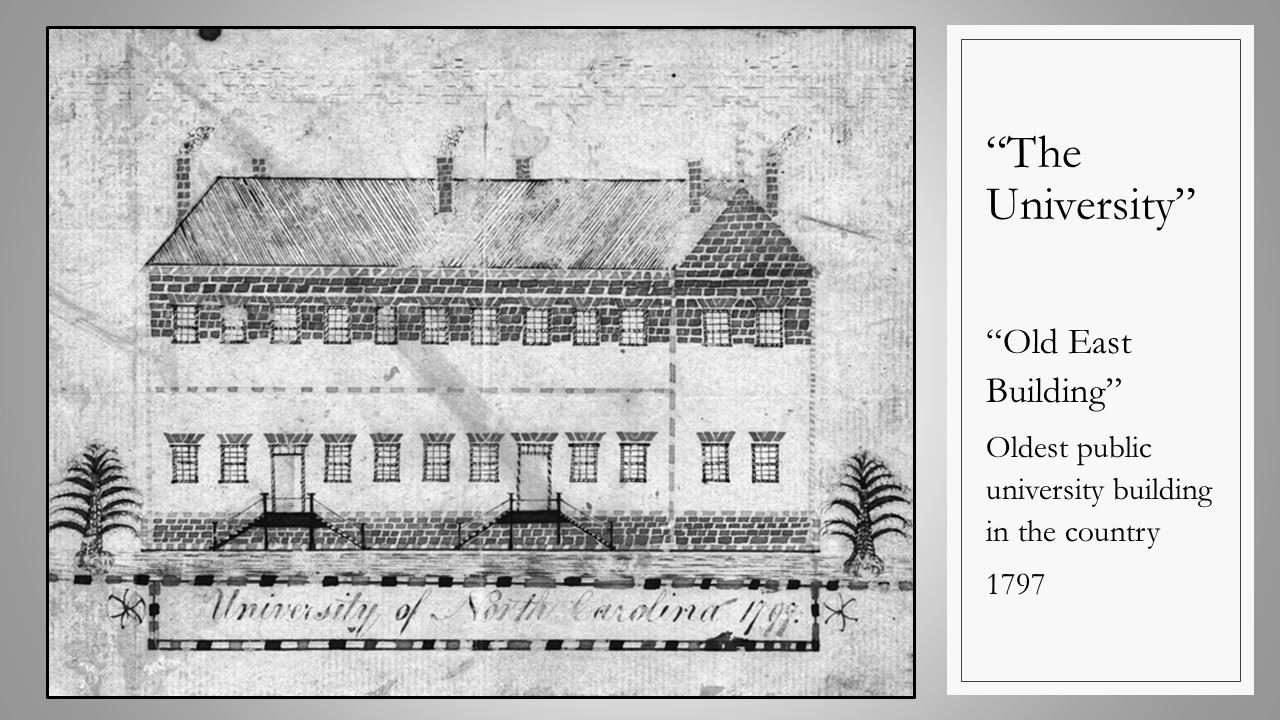
After studying at the Bingham School, the Jones boys attended “the University”. In 1840, the oldest son Algernon Sidney wrote to Eliza:
“All of our brothers are doing will [sic] at College Adolphus will graduate with a distinction proboly [sic] the first if he does as well as he has been doing since he has been there…”
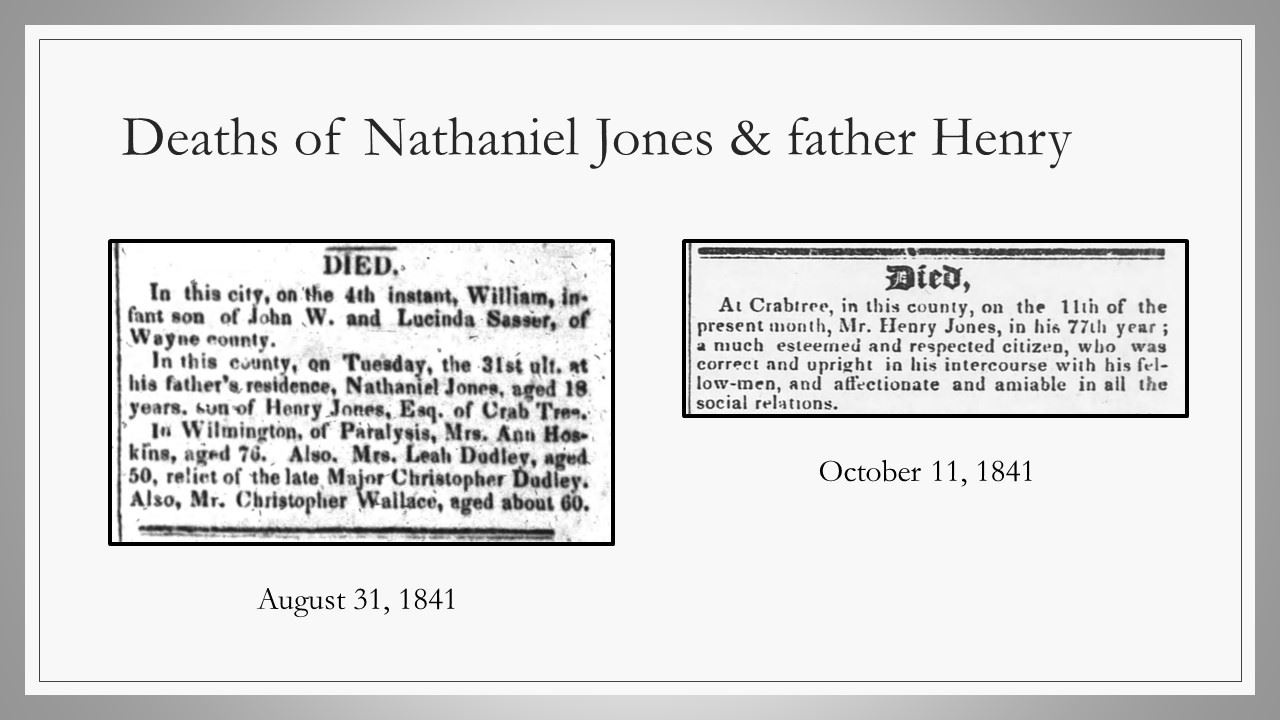
On a sadder note, the family letters also outline the death of Henry and Nancy’s son Nathaniel, who died while enrolled as a student at UNC. One letter described his stoicism in facing death, and in a letter from Amelia to Eliza in September 1841, Amelia wrote:
Our brother is buried in the back part of the garden alittle [sic] to the left of the head of the middle walk so that the grave is not seen as you approach it by that walk untill [sic] within a few feet of it.
Only a few months later, father Henry died, and he was also buried on the grounds of the house in the back garden. More details about the burials will come later.
Although the house served as a private residence, it was also noted for the people who stopped for a rest and refreshment.
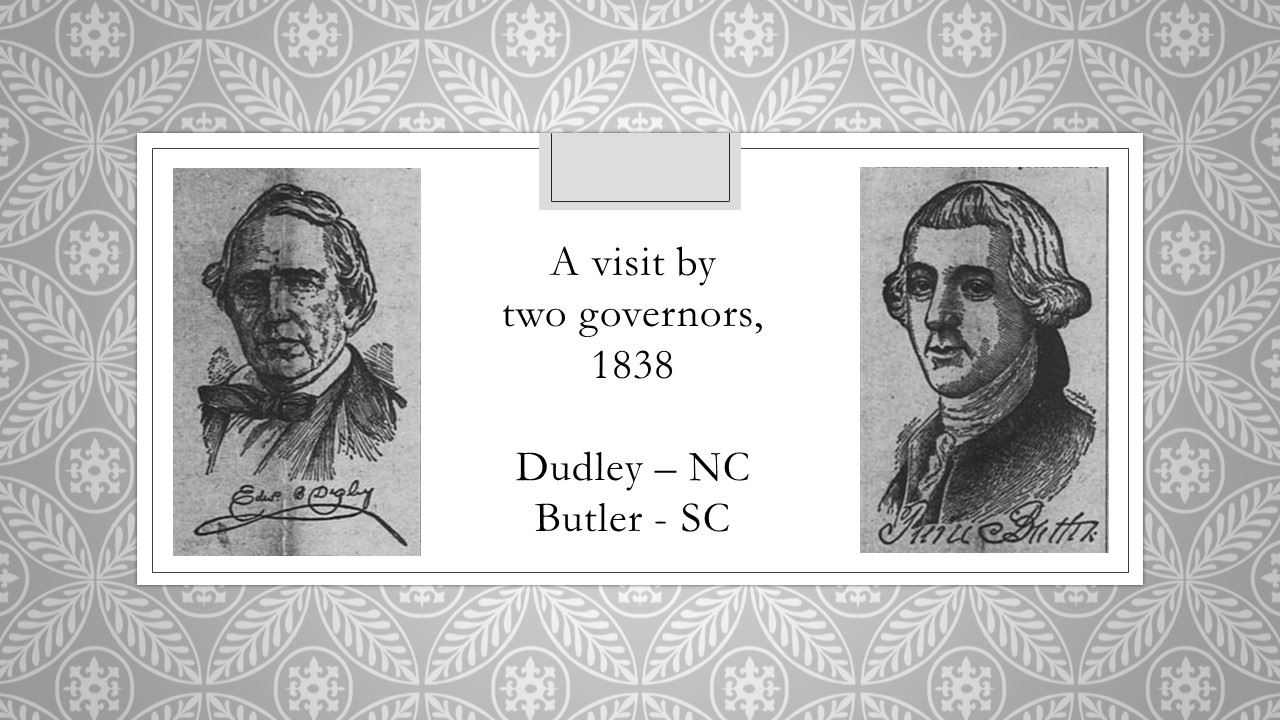
One of the most celebrated stories about the Nancy Jones House is the tale featuring the governors of North and South Carolina, who both happened to be at the Nancy Jones House, possibly imbibing some of the delicious peach brandy we have talked about.

Here is another set of images from a newspaper article. The story goes that in 1838 the North and South Carolina governors were both at Nancy Jones’ house/stage coach stop and imbibed the first round of beverage in short order. It would appear that the refill was a long time in coming. Thus, one governor remarked to the other “It’s been a damn long time between drinks!” There have been many newspaper, magazine and genealogical journal articles written about this incident and who was actually in attendance (there is some argument about that). As it is said, “details may vary”, but the most compelling recollection was an interview with Joel Whitaker, the son of Amelia Ann Jones Whitaker and the grandson of Nancy Jones. Joel stated that his grandmother told him the story with the two governors as outlined above. Some lore indicates that Nancy Jones wasn’t as offended by the use of the inappropriate word as she was insulted by the apparent slam on her hospitality!
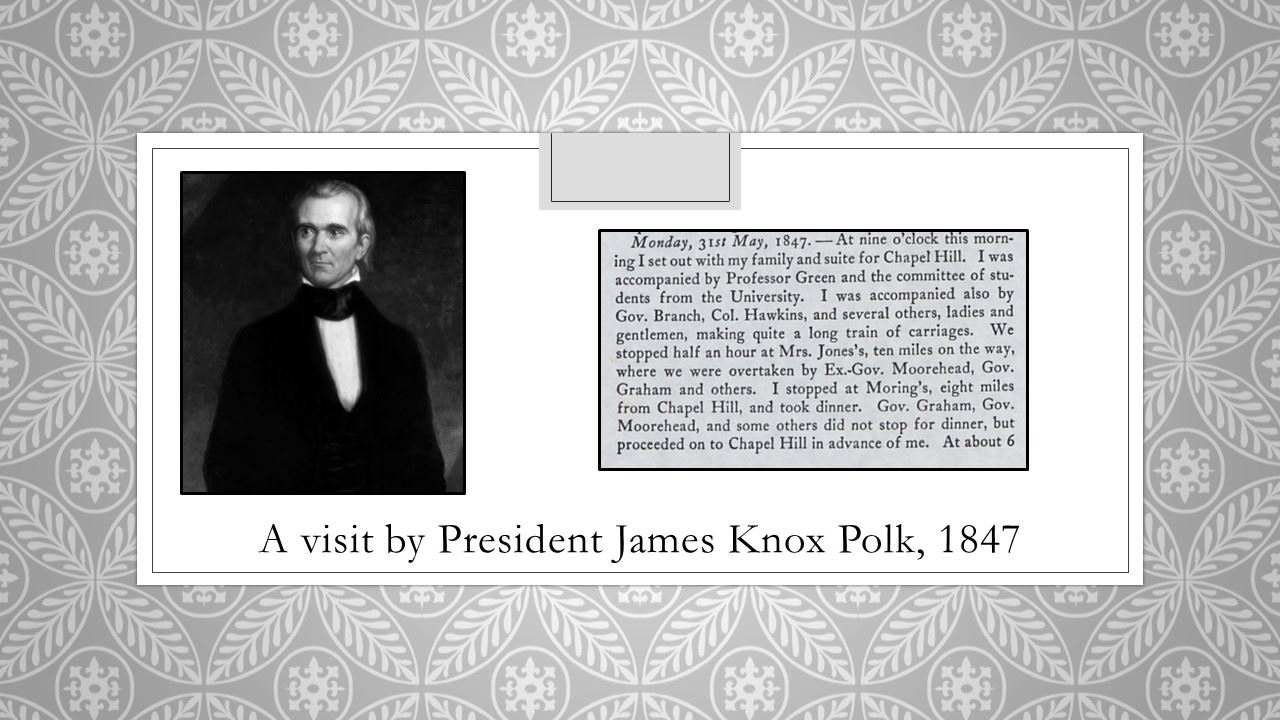
Another important visitor to the house was President James Knox Polk. Polk was born in Mecklenburg County, North Carolina in 1795 and graduated with honors in 1818 from the University of North Carolina. While serving as the 11th president of the United States, he was asked to deliver the commencement address to the graduating class of UNC in June 1847. He kept a diary and we find this excerpt:
Monday May 31, 1847: “At nine o’clock this morning I set out with my family and suite for Chapel Hill. We stopped half an hour at Mrs Jones’s, 10 miles on the way…
The party arrived at about 6:00 pm in Chapel Hill, quite a long day of travel! Unfortunately, we are left to wonder if peach brandy was served to the President!
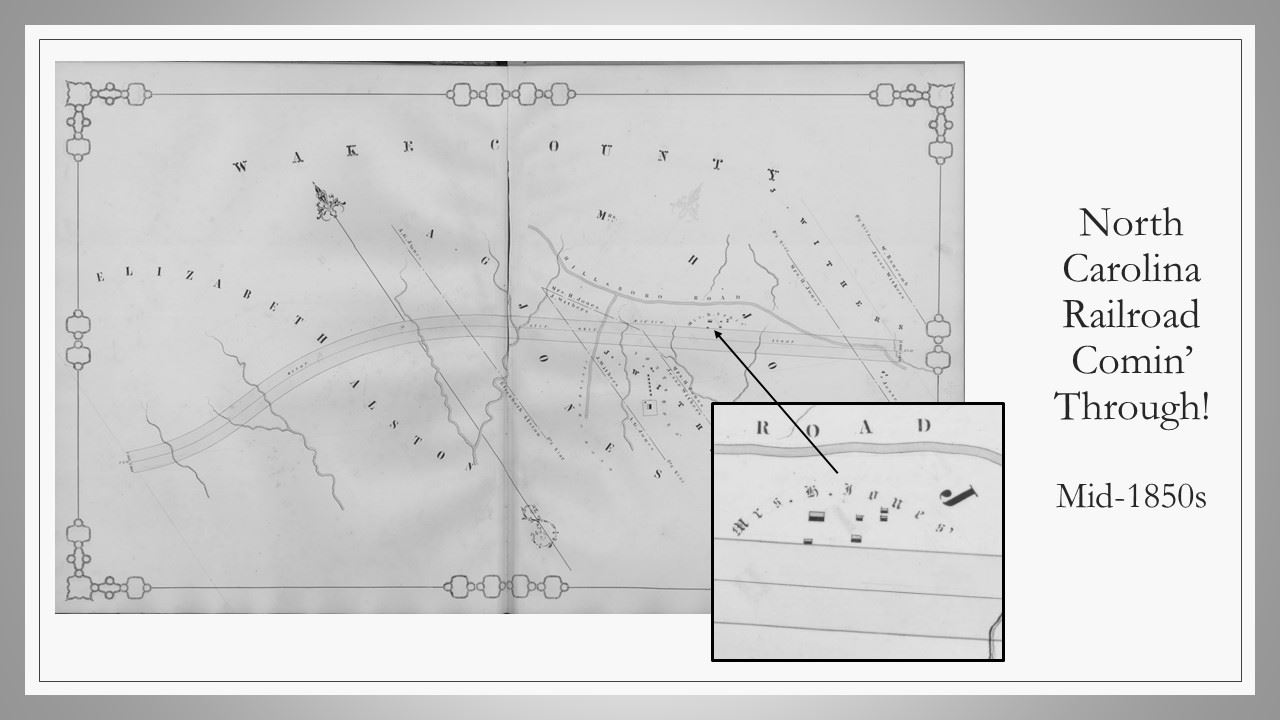
Not long after President Polk’s visit, the latest technology was being planned for North Carolina – the railroad. The North Carolina Railroad drew up maps of all the right of way properties the railroad was purchasing in order to run the railroad line in an arc across the state. In this portion of the map, we see that the Nancy Jones (Mrs H Jones) property was located along the railroad right of way. In the close up, you can see the buildings on the property. The line was constructed in the mid-1850s, and even the railroad got a mention in family letters. There was some fallout from unexpected consequences along the rail line. Here is Rufus, Nancy’s son, telling a tale on his mother in a letter to his brother-in-law, Dr John Young in 1857.

Rufus wrote:
“I was to see Ma yesterday. she enjoys unexampled health for one of her age… Occasionally her feelings are upset by having an old cow, that has paid for herself a time or two in butter, run over by the Cars and killed, but that, I have no doubt, is the case with all the old women on the Rail Road, who seldom migrate beyond their own yard fences. They imagine that because they do not hear of it, that the Cars never kill the old cows and pigs of no one else but themselves.”
When the Nancy Jones House was being inspected after the move to its present location, a short section of track was found in one of the chimneys which had possibly been inserted to shore it up. Analysis showed that it was probably a part of the original railway line. I wonder, could it have been part of the section of rail where the unfortunate cow met her maker?
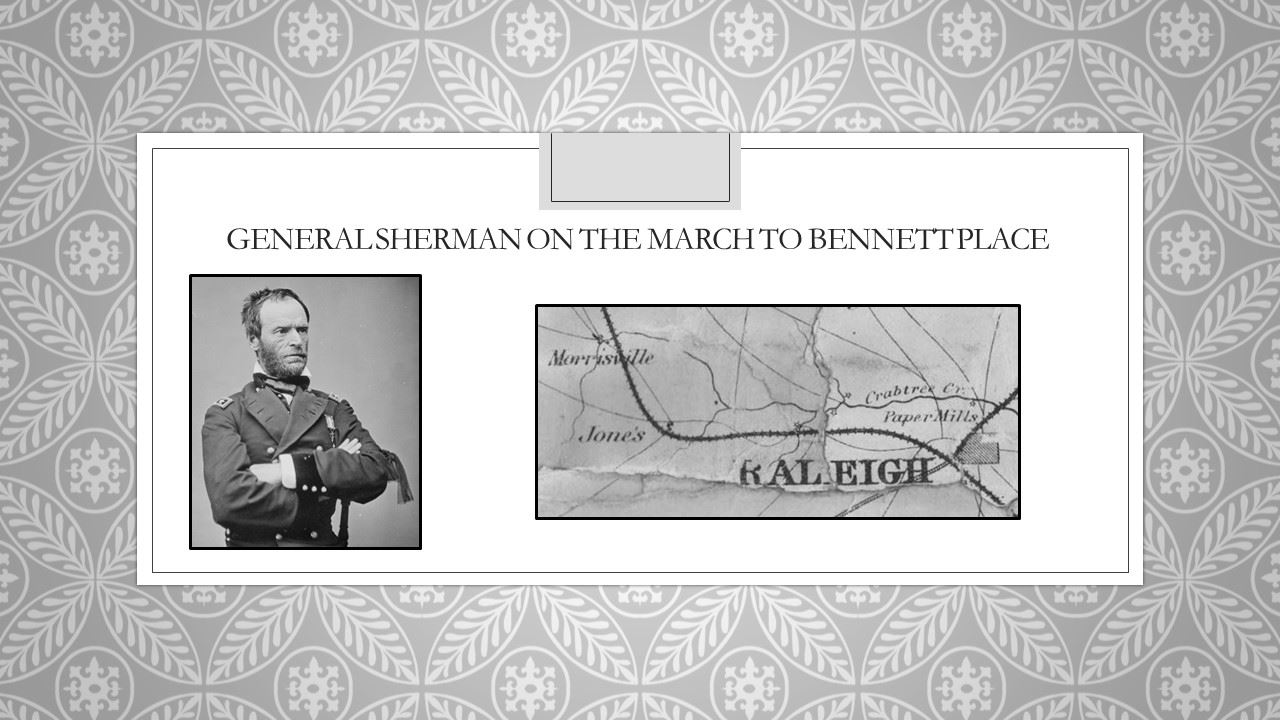
The next event of note in our area was the Civil War. By this time, the 1860s, the area around the house had grown up and was known as Jones or Jones Station, as noted on this map from around 1858. Neither Cary nor Page’s Station or Turnout is shown, just Jones and Morrisville. Cary was not formally incorporated until years later, 1871.
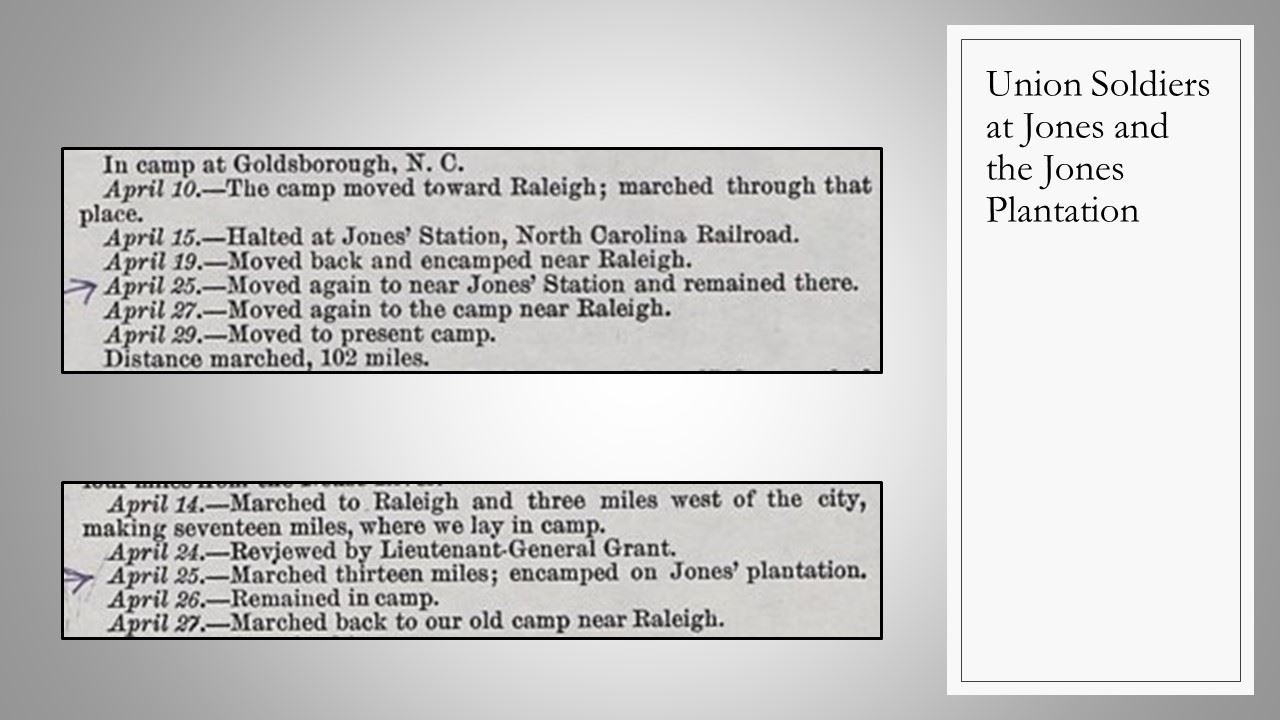
By the end of the Civil War in 1865, General William Tecumseh Sherman’s troops were on the march through North Carolina, heading to Bennett Place in Durham, where Sherman would preside over the largest surrender of Confederate troops of the war. Reports from various regiments showed that troops marched from Raleigh to Jones’ Station and beyond. And we see that Union troops camped on the Nancy Jones property and the surrounding area on their way to and from Bennett Place.
The Jones family was one of some families in the area who had enslaved people on their land. One of the enslaved women on the Rufus Jones property, named Clara Jones, gave this account in her WPA Slave Narrative in the 1930s. To set the scene, during the war, Nancy’s son Rufus and his wife, Sarah, or Sally, Jones lived along the Old Pittsboro Road, just down the road from Rufus's mother Nancy. What follows is an exact transcription of the account recorded by the WPA worker.
Clara Jones said, “When de Yankees come, Mis’ Sally, Marse Rufus’ wife, cried an’ ordered de scalawags outen de house but they jist laughs at her an’ takes all we got. Dey eben takes de stand of lard dat we has got buried in de ole fiel’ an’ de hams hangin’ up in de trees in de pasture. Atter dey were gone, we fin’s a sick Yankee in de barn an’ Mis’ Sally nurses him. Way atter de war, Mis’ Sally gits a letter an’ a gol’ ring from him.”
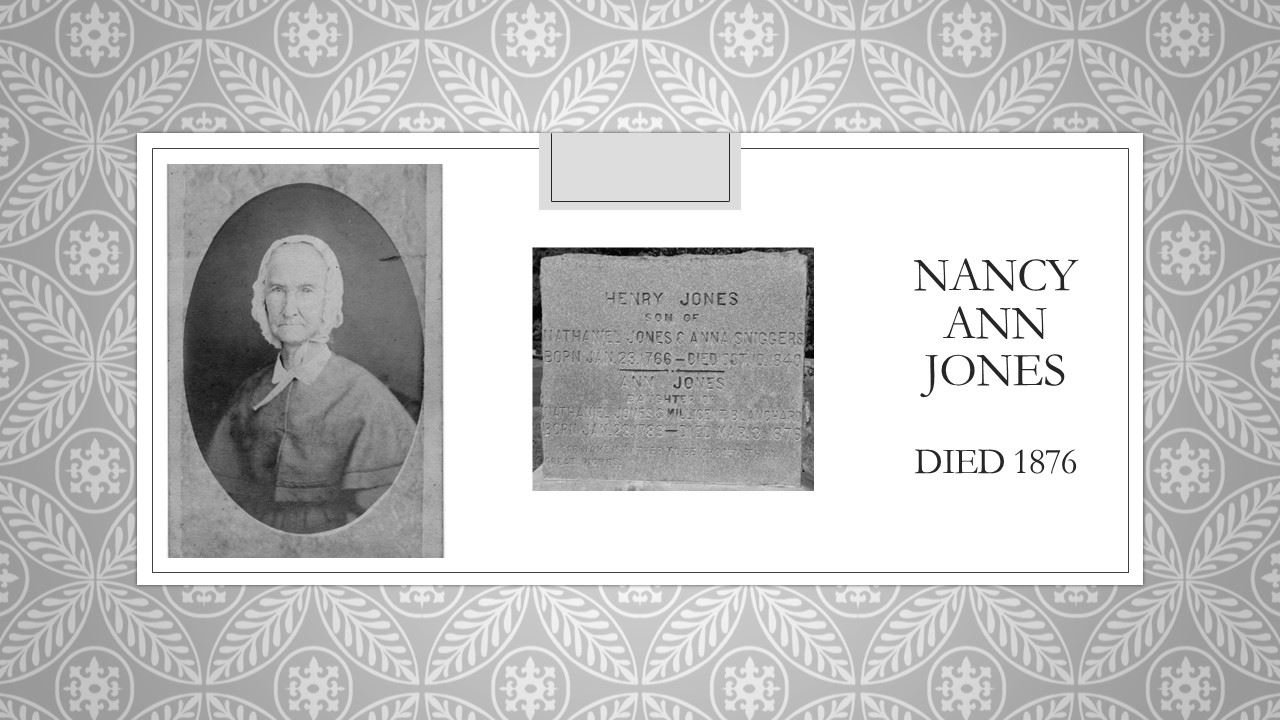
As of 1874, Adolphus, Nancy’s youngest son, wrote to Eliza that, “Mother will be 91 years old in a few days… She retains the faculties of her mind pretty well but her physical powers are gradually giving way. She walks about the yard and garden – sometimes she walks over to a near neighbor’s house.”
But, finally the inevitable happened and an era came to an end with the death of Nancy Jones in 1876. After Nancy Jones’ death, Nancy’s youngest son, Adolphus Jones, lived in and ran a school out of the house for a while, at or around the time Cary Academy/High School was being established in Cary. Rufus and his wife Sarah had moved to Cary proper, and Sarah’s brother, A H Merritt, was the school’s first principal. It was a small, tightly interconnected world in Cary’s early history.
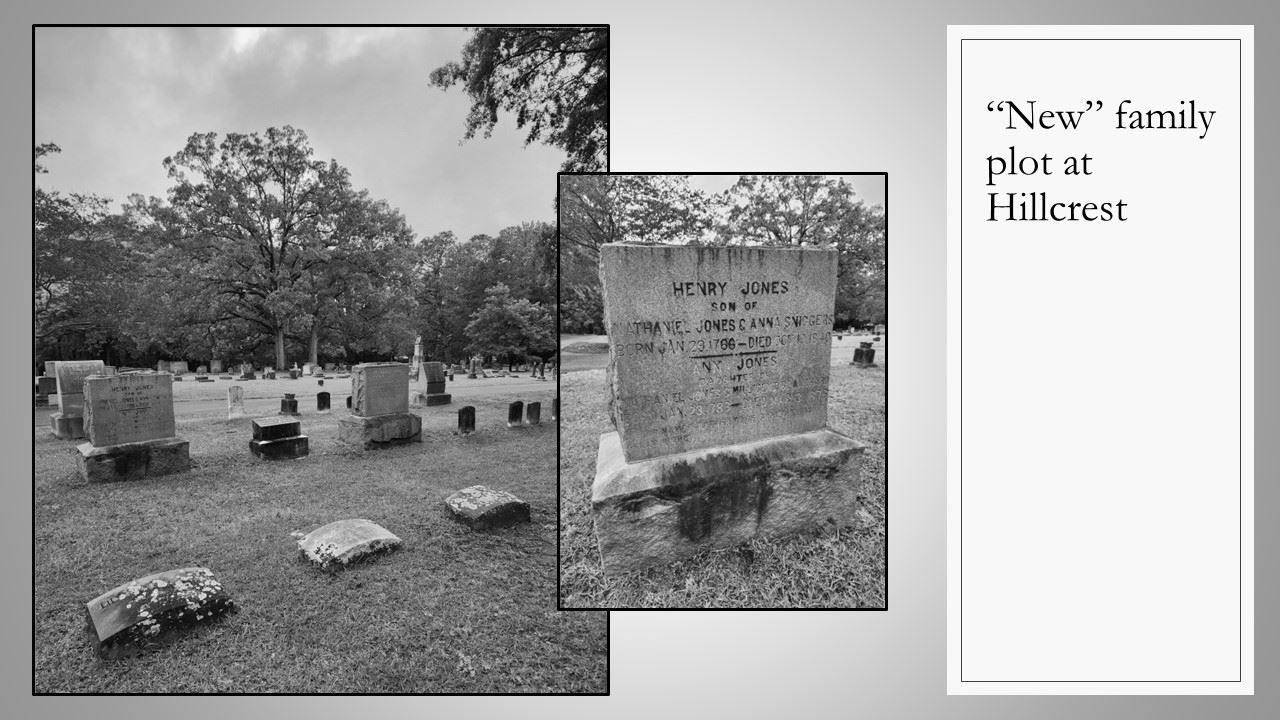
In 1878, Rufus wrote to Eliza letting her know about plans for the homeplace property. Adolphus, as a representative of the family, was selling the homeplace, so what were they going to do about the burials in the back garden? Rufus wrote, “I ought to have mentioned that Ma died 3rd March 1876 and just here while I think of it Sister, I wish to make a request of you which is this, that you furnish me, if in your power, with the date and year of Pa and bro Nat’s deaths, we have removed their remains to the Cemetery in our little village of Cary, and wish to mark their graves with suitable slabs. I suppose you have perhaps some old letters conveying to you the intelligence of their deaths.” Henry and Nathaniel’s graves along with graves of infant children formed the nucleus of Hillcrest Cemetery on land originally owned by Rufus and Sarah Jones.
Adolphus sold the house to S R Horne and moved to Cary. After Mr Horne, several families owned the property in the late 1800s and early 1900s. We have no details about these owners.
However, a "Cary News" newspaper article in 2000 related a number of interesting anecdotes from a later era of the house. Russell Heater is a familiar name to many Cary locals. The Heater family was originally from West Virginia and came to Cary around 1913 and started a well drilling business. Russell Heater was known as “Mr. Cary” for his love for Cary and his promotion of Cary as a great place to live. His son Bob Heater was an infant when the family began living in the Nancy Jones House for several years in the days of the Great Depression.

Bob Heater said that his older sister, Margaret, was old enough to remember hobos from the railroad who would jump off the cars and come to the house to ask for food, along with hobos traveling the road in front of the house. Mrs. Heater always had cornbread baking and would share portions with them. Margaret also told about a sturdy peach limb that was kept by the back door in case of trouble from the hobos. There must have been local peach trees on the property for some time after the peach brandy era!
The Depression also took its toll on the Heater family, and Bob remembered the regret that the family felt in having to sell the big crystal chandeliers in the living and dining rooms to raise money when the well digging business went bankrupt. Another anecdote Bob told was that men would drive up to the house seeking “services,” thinking that prostitutes lived and/or worked in the house (There is no image for this topic!). Mr Heater would disabuse them of that notion, and Mrs Heater would slam the door in their faces! Margaret never doubted that the house was haunted. She told about hearing footsteps and summoning her father to come search for the perpetrator, but no one or nothing was ever found.
![]() One final anecdote from this era! Once, when Margaret’s father, Russell, was away, the family heard what they called an “ungodly sound” in the night. Their Aunt Opal, who was staying with them and apparently “was not afraid of the devil” in Bob’s words, “got a flashlight and a gun and went down to the cellar and saw red stuff that looked like blood seeping out from the bottom of the wall. She picked up something and banged on the wall. Part of the wall collapsed and behind it was a wine cellar filled with bottles of wine that had exploded from the summer heat.” Just wondering… could some of it have been well-aged peach brandy?
One final anecdote from this era! Once, when Margaret’s father, Russell, was away, the family heard what they called an “ungodly sound” in the night. Their Aunt Opal, who was staying with them and apparently “was not afraid of the devil” in Bob’s words, “got a flashlight and a gun and went down to the cellar and saw red stuff that looked like blood seeping out from the bottom of the wall. She picked up something and banged on the wall. Part of the wall collapsed and behind it was a wine cellar filled with bottles of wine that had exploded from the summer heat.” Just wondering… could some of it have been well-aged peach brandy?
![]()

Bob Heater said that in the end “Mother wouldn’t stay there because she couldn’t keep the doors locked." The doors would be locked at night and found unlocked in the morning. Ghosts again? Mr Heater bought the red brick bungalow on the corner of Dry and South Harrison Avenues, and the family moved to downtown Cary, leaving the Nancy Jones House, and possible ghosts behind.
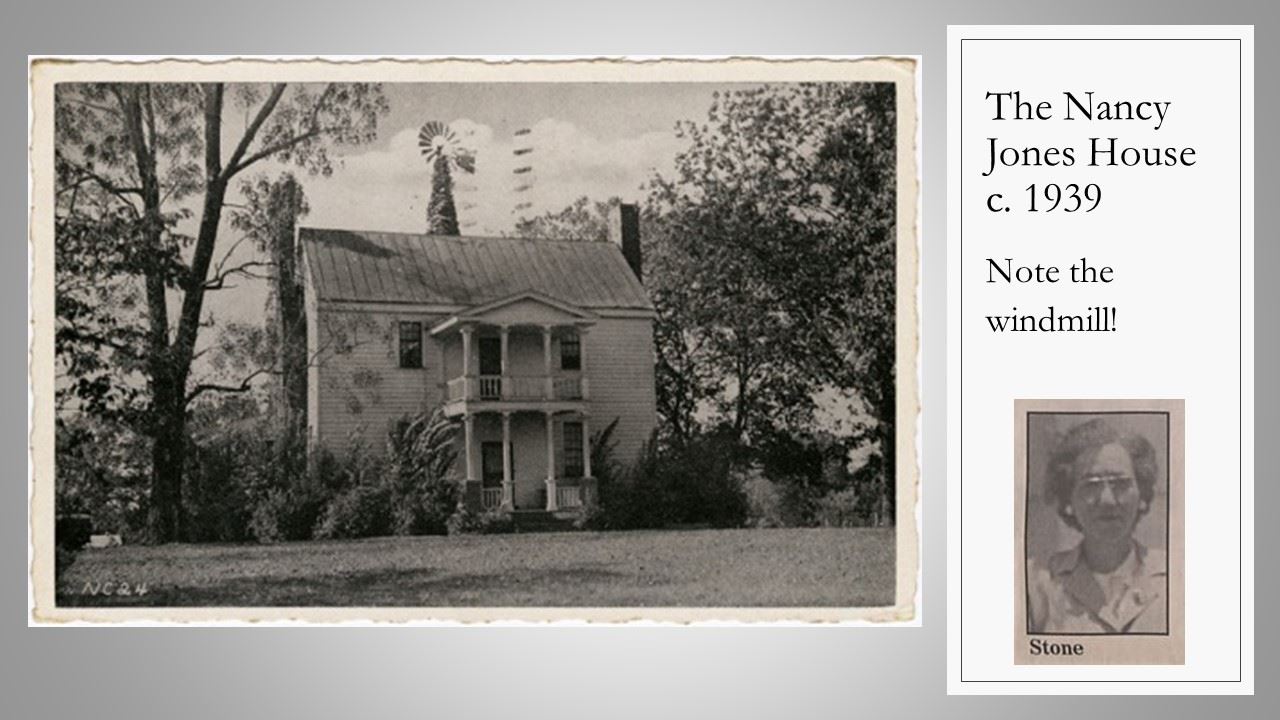
In 1935, Thomas and Audrey Stone bought the property. The windmill, pictured here, blew down in the 1940s during World War II, and the scrap metal was used in the war effort. Mrs Stone lived in the house until her death in 1991. The article went on to say, Audrey “never wanted to leave this house… She was very proud in 1984 when it was put on the National Register of Historic Places. Anybody who stopped and wanted to look at the house, she would always let them in.” After her death, a succession of families lived in the house. Many reported unusual creaks and sounds unlike any other properties they had lived in. In the late 1990s, Kent Henley rented the house, became its caretaker and refinished the 2” thick plank floors and painted the interior. HE thought the noises in the house were not unusual and attributed them to the wind!
Moving forward a number of years, the large property, including the house and acreage, was purchased by the Sri Venkateswara Temple. The temple sold the house to the Town of Cary in 2019 with a proviso that the house would be removed from the property.
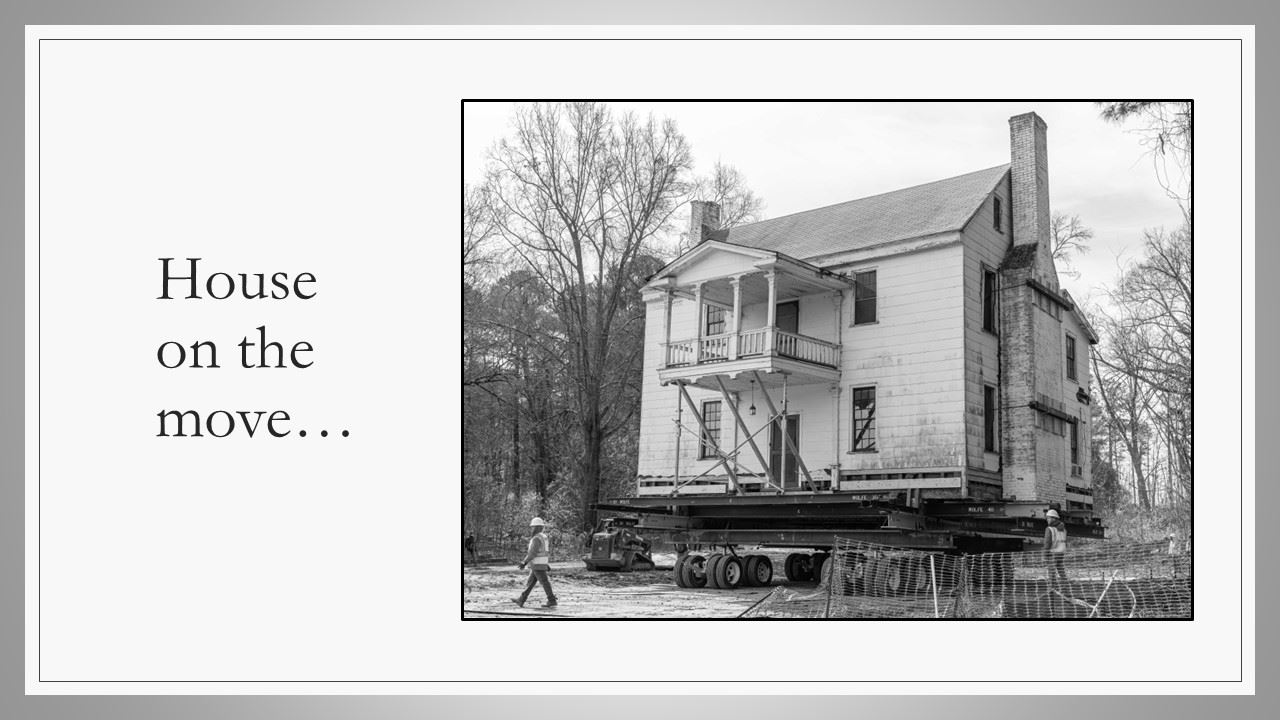
The Friends of the Page Walker are grateful to the Town of Cary for purchasing and saving the house. For the most recent history, in March 2021, the house was successfully relocated to a town-owned parcel approximately 500 feet east of the original site. The National Register designation was reassigned when a new application was submitted. The house continues to front onto Chapel Hill Road so it has retained its historic orientation to the former stage road.
In early 2022, Cary's Historic Preservation Commission initiated the process to recommend the Nancy Jones House be designated as a Local Historic Landmark. This process included having two commission members visit the house, assess the house for historic integrity, and report back to the HPC. Following this assessment, a consultant was hired to complete the nomination report. In August 2022, the nomination report was forwarded to SHPO for their comment. The designation process continues.
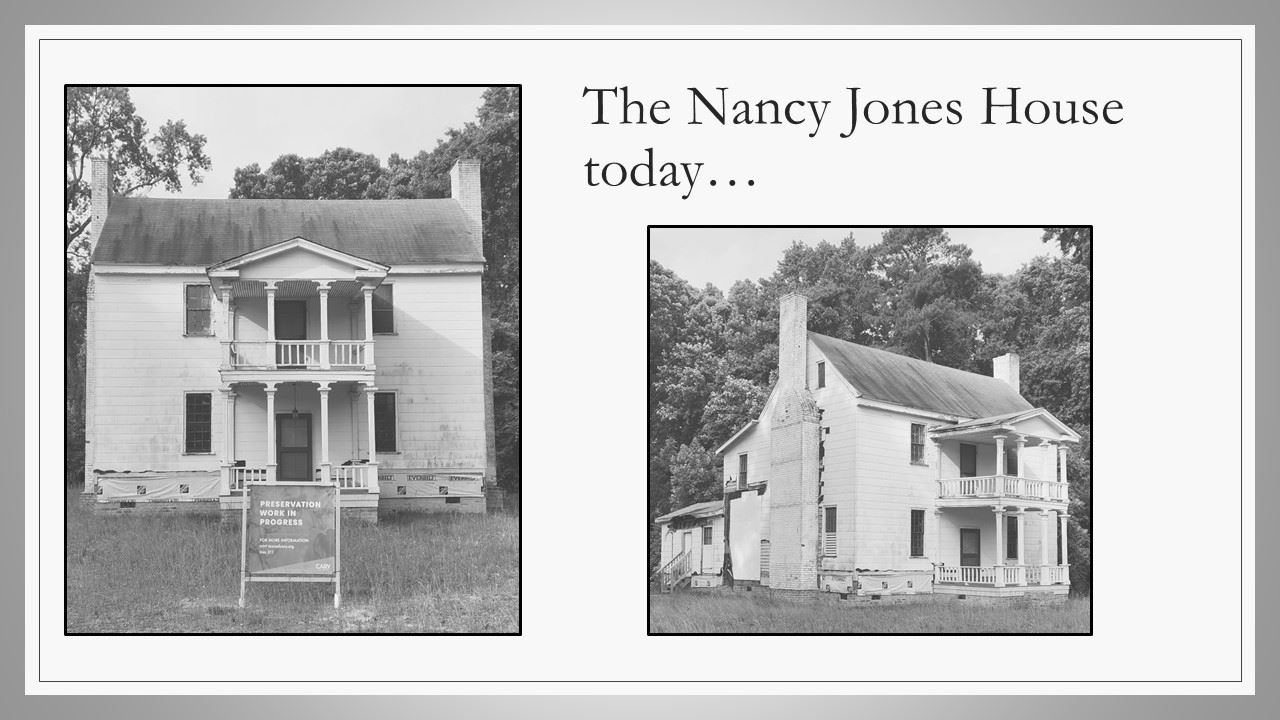
Today, the Nancy Jones House stands ready for a new beginning, some 220 years after it began its life, around 1803. What the Town will use it for remains unclear, but the house’s historical, cultural and social significance cannot be overstated. Let’s hope a truly fitting use for the house will be decided on in the very near future, that it will include the telling of its history and provide public access, and that renovations will showcase a shining white house along the old stage road from Raleigh to Hillsborough once again. When that happens, let’s toast the occasion with peach brandy!
